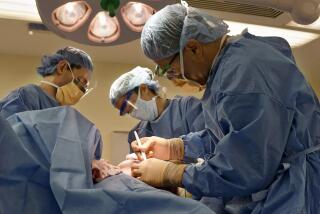Gastric bypass weight-loss surgery even better for heart health in teens than adults, study finds
Gastric bypass surgery has been shown to reduce the risk of cardiovascular disease in adults, but it may be even more effective at reducing risk in teens, researchers said Monday. Although the weight loss in both groups was about the same, the surgery, formally known as Roux-en-Y surgery, gave teens a greater improvement in a variety of biochemical markers that are normally thought to be predictive of heart problems, researchers from the Stanford College of Medicine reported at a Digestive Diseases Week meeting in Chicago. This is âa unique finding,â said Dr. Craig P. Fischer of the Methodist Hospital in Houston, who was not involved in the research.
Obesity is a growing problem in the United States among adults and youth. Some studies indicate that at least one in every five adolescents can now be considered obese. For many, surgery is the last resort for shedding the excess poundage.
Dr. John M. Morton, a bariatric surgeon at Stanford, and his colleagues studied 99 adults and 33 adolescents who underwent gastric bypass surgery at Stanford from 2004-10. The adults had an average age of 44.4 years and an average body mass index or BMI of 52.3, indicating that they were severely overweight. The adolescents had an average age of 17 and an average BMI of 52.7. The team examined a variety of biochemical markers, âthings that help predict whether someone is going to have a heart attack down the road,â Morton said. The markers included diabetes status, blood pressure, lipid levels, cholesterol levels, C-reactive protein and homocysteine (an amino acid) levels in the blood. âThe results were eye-opening for us,â he said.
In the 12 months of follow-up, both groups lost about 70% of their excess weight, although the teens lost slightly more. âEveryone did well, and got substantial reductions in risk factors,â Morton said, but teens did even better. They showed a higher improvement in high-density lipoproteins (the so-called good cholesterol) and sharper drops in homocysteine levels and fasting glucose, which is a marker for diabetes. They did especially well in reducing levels of C-reactive protein, âwhich is probably the most predictive of all risk factors,â he said. Normal levels of C-reactive protein are below 3.0. The teensâ average levels went from 7 to 1.4.
At least part of the increased improvement, Morton said, may have arisen because the teens were âa bit more receptive to doing exercise,â which by itself is known to improve many of the risk factors.




